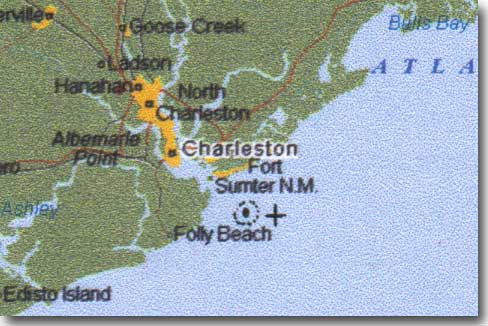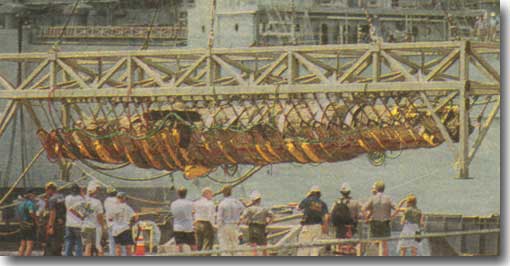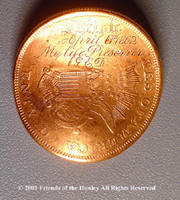|
Introduction.
I first noted the Confederate submersible H L Hunley's place in Naval History, when I wrote my Under Water Warfare. The Struggle Against the Submarine Menace 1939-1945 in 1997.
Off Charleston, South Carolina, in 1864, it had despatched the Union warship USS Housatonic, and itself to the ocean floor, to mark being the first submarine in history to sink a warship.
This then, is the story of it's success, demise, and, in 2000, it's discovery and resurrection from its watery grave.
H L Hunley.
We need to backtrack to the 1860's, when two partners who ran a machine shop in New Orleans, James McClintock and Baxter Watson, who, with financial help from a Louisana lawyer Horace Lawson Hunley, came together to produce three versions of a submarine.
Their first effort was scuttled to prevent it's capture by Unionists from the North, the second model foundered to be lost in heavy seas. The third and final try named after H L Hunley was completed in 1863 at Mobile, Alabama, and shipped to the port of Charleston by train.
Description of submarine H L Hunley.
Hunley was about 40 feet long, and weighed in at about 20 tons.
She was powered by seven men hand turning a crankshaft running the length of the vessel to a fly wheel which was linked by chain to the propellor.
Iron blocks or weights were bolted to the submarine base to give ballast to the keel, there was a release mechanism so these weights could be released should the boat be caught on the bottom.
Snorckel Tubes.
Hunley pioneered the use of a snorckel or breathing tube, being fitted with two of them plus bellows which drew fresh air into the submarine.
It was not until WW2 that German U-Boats came up with a sophisticated version of the Schnorchel breathing tube.
Depth Control.
To control depth, there were ballast tanks both in the stern and bows, these were flooded to sink the vessel, and pumped out to bring it up towards the surface.
To Navigate the submarine.
The 8th. crew member and Captain was seated at the steering helm, and could use a compass, but needed to visually sight through a viewing window to find a potential target.
The boat carried lateral fins to allow depth changes, so that water did not need to be either added to or removed from the ballast tanks.
The Torpedo or Mine.
About 135 pounds or 62 kilograms of an explosive charge with it's exploder were carried at the far end of a 20 foot long spar.
This so called torpedo was more realistically a mine, and it needed to be rammed into a target ship, the charge stayed in place, but the submarine now had to be cranked in reverse, (a) to get out of harm's way and (b) to cause a line attached to the trigger mechanism on the explosive charge to unreel, and when the end of this line payed out, to trigger the charge.
Hunley at Charleston.
At this stage of the Civil War, the Confederate port of Charleston was besieged by Union ironclad warships.
Hunley had made a number of night time voyages into Charleston Harbour, but failed to achieve any success.
Imagine the effort made by her crew, all seven of them toiling at their hand cranking stations, to propel their ship out to sea looking for a suitable target, none in sight, the sheer frustration of it all , and then having to crank for some further miles home again. All completed in extremely cramped quarters, with the air starting to foul, and in extreme danger at all times.
USS Housatonic anchored about 4 miles off Charleston.
On the night of the 17th. of February 1864, the Union steam sloop USS Housatonic was at anchor some 4 miles off Charleston, it was time for H L Hunley to go into action.
Site where USS Housatonic was sunk by the Confederate submarine H L Hunley in 1864, and where the latter vessel was found. The dot with the circle around it is Housatonic, whilst the cross is where Hunley was found.
 |
With Lieutenant George Dixon in command and at the helm, his crew cranked away to allow him to approach the enemy Union ship. To make his final run into attack, Dixon needed to surface, so he could visually line up his target.
John Crosby, the acting Master in Housatonic, at 2045 (8.40 PM) sighted an object off his starboard beam, and as he had some warning of an impending attack by the Rebels, he sounded the alarm. His crew rushed to defend their ship with a flurry of small arms fire, but too late, Hunley struck with her ramming spar on the enemy's starboard side, and below her waterline.
The submarine reversed, detonating the charge, and destroying a large section of Housatonic.
Success! for the first time in Naval History, a Submarine had used an under water weapon to destroy an enemy ship.
Alas! H L Hunley and her crew never returned to their base, and their fate was unknown.
Locating the sunken H L Hunley.
In May of 1955, some shipwreck searchers led by Clive Cussler found the missing submarine about 1000 feet away from the spot where she had sunk USS Housatonic so long ago.
She was laying under 3 feet of silt which had built up and hidden her since 1864.
Recovery of Hunley.
Over 5 years a group of both engineers and archaeologists planned how they might salvage this historic Naval vessel, and preserve her for posterity.
Hunley snug in her hammock, freed from the ocean floor after 136 years.
 |
On the 8th. of August 2000, the barge Karlissa B, fitted with a large lifting crane was in position over the wreck, when planning to recover the submarine, a real worry was the possibility of this relic breaking apart when trying to bring her to the surface. To avoid such a possibilty, slings were passed beneath the boat and attached to a supporting hammock which would envelop and cover the whole vessel. Over each sling were placed bags, which in turn were filled with polyurethane which was expanded to form a cushioning medium that followed the shape of the hull.
This recovery effort cost $US 2.7 Million, and 19 divers were employed who spent 3 months preparing before the lift was ready to be tried.
The water was so murky that the divers could only work by touch, and by use of hand held suction dredges they excavated 25,000 cubic feet of mud /sand to expose Hunley from the silt built up over the years it lay on the bottom.
The moment of Truth.
At last, all possible precautions taken, the order to lift was given, it took but 6 minutes for Hunley to break out of the ocean that held her prisoner for 136 years.
She lay snug in her padded hammock and slings.
What was to be found inside of Hunley?
All 8 men who crewed Hunley were found at their positions within the submarine.
Lieutenant Dixon's $20 lucky gold coin, fact or fiction?
There had long existed a story which said Lieutenant George Dixon always carried with him a momento, a $20 gold coin, given to him by his 16 year old sweetheart Queenie Bennett, he kept this coin in his pocket where it had deflected a Yankee bullet at the Battle of Shiloh. After this battle, George engraved his lucky gold coin with " My Life Preserver."
I now quote from the National Geographic Magazine July 2002 issue Page 100:
The archaeologist Marie Jackobsen, was probing George Dixon's skeleton prior to removing it from the Submarine. She was well aware of the story of the gold coin, not knowing what to expect, but her fingers touched a ridged surface. "I knew instantly it was the edge of a coin" she said. The coin was warped, one side buffed smooth, but it was engraved and read: "Shiloh April 6 1862. My Life Preserver, G.E.D."
After all, the improbable tale had proven to be true, it also confirmed that this skeleton at the helm was that of Lieutenant George Dixon.
 The other 7 crew members have yet to be formally identified, but what caused the death of the entire crew may prove to be unanswerable. The other 7 crew members have yet to be formally identified, but what caused the death of the entire crew may prove to be unanswerable.
The Deadly Hunley Experiment.
Hunley and her two predecessors proved more deadly to the Confederate cause than she did to the Union side. The first submarine, killed 5 crew in one dive she made, the second prototype, which Horace Hunley himself took down, and failing to close a ballast tank resulted in him killing his crew of 7, plus himself.
When the third built submarine H L Hunley did not return, all her crew of 8 were also lost, thus in all, 21 men perished on the Confederate side of the ledger, and for the Unionists, all 5 aboard USS Housatonic died, 21 versus 5.
Conclusion.
When all tests are completed on the skeletal remains of Hunley's crew members, it is planned to lay them to rest alongside Horace L Hunley, in a Charleston cemetery called Magnolia.
H L Hunley, the first submarine to sink a warship, and the mystery of her disappearance 136 years ago was finally solved.
|